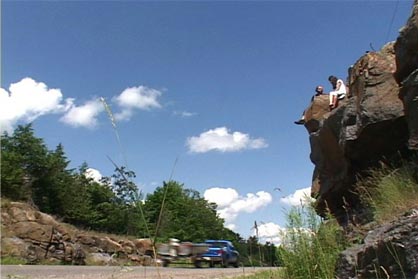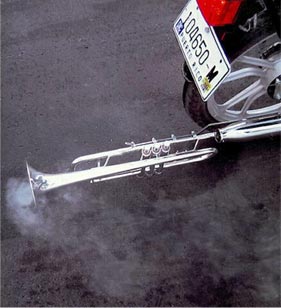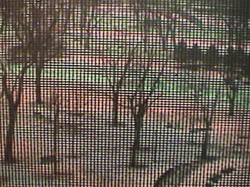
|
Lorna Mills and Sally McKay
Digital Media Tree this blog's archive OVVLvverk Lorna Mills: Artworks / Persona Volare / contact Sally McKay: GIFS / cv and contact |
View current page
...more recent posts

Neurologist Vilayanur S Ramachandran on art (from BBC Reith Lectures 2003 online) (thanks to Marc Ngui):
Let's assume that 90% of the variance you see in art is driven by cultural diversity or - more cynically - by just the auctioneer's hammer, and only 10% by universal laws that are common to all brains. The culturally driven 90% is what most people already study - it's called art history. As a scientist what I am interested in is the 10% that is universal - not in the endless variations imposed by cultures. The advantage that I and other scientists have today is that unlike we can now test our conjectures by directly studying the brain empirically. There's even a new name for this discipline. My colleague Semir Zeki calls it Neuro-aesthetics - just to annoy the philosophers.Ramachandran's 10 universal laws of art:
- Peak shift
- Grouping
- Contrast
- Isolation
- Perception problem solving
- Symmetry
- Abhorrence of coincidence/generic viewpoint
- Repetition, rhythm and orderliness
- Balance
- Metaphor

G.L.N., Space Ship Earth: Highway 44, 2004. From the Power Plant website
I was recently in conversation with a group of artists, all of whom were upset about Sarah Milroy's Globe and Mail review of the current Power Plant show, Dedicated to you, but you weren't listening. Having neither seen the show, nor read the review, I kept my mouth shut except to ask, "Did you disagree with her?" The answer I got was indirect, "She acted irresponsibly when she trashed the younger, local artists." This is a normal, almost commonsense point of view, but it kind of bugs me. Wouldn't it be more irresponsible for a journalist to hold her tongue, and refrain from calling it as she sees it? Art writing is hard, all the community pressure on a writer is towards promotion, while the editorial pressure is towards sensationalism and "news." I respect Milroy for sticking to her own path and if she errs on the side of crabby rather than chummy I'm all for it. All that said, I sometimes disagree with Milroy's point of view. So I went to see the show for myself.
I was impressed with the low-key metaphysics, ambition and transcendence, with a minimum of sensationalism. Two pieces were particular highlights for me, "Space Ship Earth" by G.L.N. (Maura Doyle and Tony Romano) and "Returning a Sound" by Jennifer Allora and Guillermo Calzadilla. "Space Ship Earth" will appeal to anyone who has ever identified with David Bowie's character in The Man Who Fell to Earth. With disorienting Nicholas Roeg-style camera, the two artists set up durational shots in which they play spooky ambient music in outdoor environments, recording the indigenous sound and re-inserting it into the mix. Cars whizzing past are re-cast with technological humming undertones, blue jays cries are repeated, wind and water are amplified. Sun and shadow play subtle visual games, casting grasses and rocks as the visual protagonists, throwing the environment, and by extension the planet, into surreal relief. In one sequence, an agitated black cat prowls in front of the camera, often blocking the view entirely. In another the artists and their gear are hidden in a meadow of tall grasses and wildflowers that fill the screen. In my favourite sequence, they sit perched high on a rock by the highway, the passing cars like space ships or weird animals, the clouds above suspended like space ships or weird animals in a perfect blue sky.

Jennifer Allora & Guillermo Calzadilla, Returning a Sound, 2004.
From the Power Plant website
In Jennifer Allora and Guillermo Calzadilla's "Returning a Sound" a young man rides a scooter with a trumpet attached to his tailpipe. This produces a remarkable compelling tone, that shifts range and volume as he revs the engine. Chin held high, the guy zooms past buildings, beaches, enormous trees dropping flowers and lush green fields, the trumpet ringing out a surprisingly muscial call. He is riding around his home on Vieques — an island off Puerto Rico — which was used by US military as a bombing test site for 60 years. The piece is an eloquent but undidactic testament to the work of local protestors who eventually managed to reclaim their land.
Another notable piece was "Open Access," a doorway cut into the west wall by artists Julio Castro, Gabriel Cazares and Roland Flores. The door swings open, providing free gallery access to anyone who wanders in. Dan Graham's "Opposing Mirrors and Video Monitors on Time Delay," was an optical adventure in disorientation, but we expect nothing less. Dave Allen's charismatic starlings have tons of personality — and they look happy in their gigantic cage — although the idea that they might begin to vocally mimic the musical compositions that are being played for them seems somewhat incidental to the novelty of looking at starlings as if they were precious and interesting creatures (they do have beautiful plumage, as a matter of fact, and a plucky urbane style).
All the works involve some form of collaboration. According to curator Reid Shier, the show poses the question, "What is the nature of authorship when multiple, perhaps contradictory, voices are invited to come together in the production of a work?" Zin Taylor's strange non-collaboration with Japanese musician Aki Tsuyuko is a case in point. Never having met Tsuyuko, Taylor made a video inspired by her music. His video is an exploration of dirt piles in extreme close up, the image breaking down into buzzing video dust in darkest shadows. The camera slowly pans by gaping holes, weird orifices in the dirt. In an accompanying booklet, correspondence between Taylor and Tsuyuko reveals that the musician is mystified, unimpressed and possibly slightly insulted by Taylor's interpretation of her music. The piece is poignant, Taylor stretches for something ineffable in the video, then sends his art across the world, and fails to make a meaningful connection. In this climate of hegemony and global trade, its an unexpected surprise.
In the light of current draconian attitudes to community postering, Derek Sullivan's "Endless Kiosk" should be a beautiful urban gesture. Placed in the public foyer outside the gallery, the piece is a pole that people can use to put up notices, art, refuse, love-letters, or whatever other paper products they'd like to share with other passersby (a fresh bucket of wheat paste is provided). Unfortunately, the area is not a functional public commons. People come to Harbourfront for specific events, usually in cars, and then leave again. They rarely linger, but when they do mingle they are strategically schmoozing and posing, not shamelessly posting promotion. The pole's offer of a public forum is so-far un-exploited, and the piece seems forlorn.
*************************************************
After writing the above paragraphs, I read Sarah Milroy's review and found that indeed, we mostly disagree. G.L.N.'s "Spaceship Earth" was by far my favourite piece, striking a deep and resonant chord, while she suggests these artists are "fiddling around on the margins." I felt that Johnathan Monk's "Searching for the Centre of a Piece of A4 Paper" was an empty, art-joke gesture, while for her it evoked "two dragonflies mating in midair, never quite achieving a resting point of consensus." Milroy's overall take on the show was negative and she ends her piece with a kicker: "These are wry, miniature epiphanies, offered up half-heartedly to the world, not quite witty or inventive enough to evoke Duchamp." Perhaps I'm just more partial to conceptual art, but overall I found the show engaging and profound. Its a good thing, though, that writers have different points of view. I don't think Milroy was gratuitously mean in her critiques, and she gave the whole show careful atttention. In my review, I left out the works that did not mean much to me, rather than digging in to criticize. Does the fact that I am an artist as well as a writer make me too chicken of my colleague's feelings, and therefore unable to be properly critical? I hope not. I'm not normally squeamish about stating my opinions. But I do make a conscious attempt to say something generative if I am going to say anything at all, and I know the boundary between being positively oriented and being scared to say "boo" is one that requires vigilance. For that reason I respect and appreciate Milroy's role as an art critic in this town, and I am glad she does not coddle the local youngsters when she truly doesn't like what they are doing.
Matthew Collings had a great article in the March issue of Art Review trashing the movie Modigliani along with Lust for Life, Pollock, and other films that represent artists in the "debased romantic tradition of the sentimental tortured charming impossible boy-man" Here's more:
Anyone used to looking at painting and having an understanding of what its about in historical terms and as a crafted object can see immediately that the art in Modigliani, which is all inept in the same way, is a mess, incoherent bundles of signs that say 'Modern Art'. But at the same time this pseudo-art is ambitious in a horrible way. Its statement is 'I am impressive. Look at me'; not 'I am the result of a ceratin type of serious endeavour, involving both the past and the present, in which the artist as a man takes a back seast in terms of ego and pride — that kind of thing simply doesn't help make forms cohere and colours harmonise; so basically you've got to knock it on the head if you want to be any good.' Instead we get something truly base. A supposedly great masterpiece by Picasso is unveiled amidst a lot of hoopla, everyone gasps at the audacity, the genius, etc, while 'Picasso' does a little proud, moved, humble but also arrogant smile, as if to acknowledge, 'Yes, I am the sex and art king of all time, but I also concede I owe my greatness to a long line of geniuses going back to Raphael, whom I listen to over my shoulder while working in my atelier!' That is, a part truth — Picasso's indebtedness to history and tradition — becomes a whole lie: art is for social climbing, for intimidating the other guy.
The next show at MOCCA (opening Saturday) is going to be good. Donigan Cumming is a strange cat who makes strange videos. Peggy Gale guest curated the exhibition. Gale herself has an interesting story. She's been Canada's expert on video art pretty much since the medium was invented. In the early seventies she curated a comprehensive cross-Canada show at the AGO called Videoscape. Back then, video art tended to be conceptual and performative, exploring the possibilities of real-time and the seeming physicality of video itself. Said Gale in her 1977 essay for Parachute, "[Video] is not 'over there,' projected away from us onto a wall or screen as is the case with film. Rather it is 'here;' it projects it's message from within, as would a person who is interacting directly with us. As such, video has a presence which demands attention."
Video art has come a long way since the single-shot days of the early 70s. No longer a reel of magnetic tape, conceptually tied to television and performance, video has become a diffused-yet-integral component of the contemporary multi-media environment. Gale, with her prevailing interest in narrative and the tangibility of ideas, is still pushing her writing and delivering insights into the medium. Hence a show by Donigan Cumming, who's work is multi-layered and challenging, twisting fiction and documentary together in a tight and disconcerting weave. His works feature people living with poverty, old age, and substance abuse. The viewer is confronted with too much intimacy: the saggy flesh, toothless maws, and abject living conditions of some very down and out people. We are invited to peek into a strange relationship between Cumming and his subjects. He is too close, in fact the narrative of desperation seems to belong to the artist as much as it does to his characters. Is this fiction, document or exploitation? If fiction, why the painfully acute level of realism? If document, why is the artist himself so present in the work?

| 
|
Says Gale, "When I was asked to curate this show I felt I could say something that hadn't been said yet. It was very hard to nail it." And nail it she did. The exhibition is accompanied by a vivid publication, more an artists' book than a catalogue, that visually puns with pixels and window screens, nutting around with the contemporary construction of video images while at the same time presenting poignant pictures of sad reality. Gale's essay is elucidatory. Here's a quote:
"The relationships between Cumming and his accomplices are complex. Some have become his friends, and stay in regular touch; others surface only in the photos and video works. These touch on the tradition of "concerned photography" with its probing of issues and personal trauma; the resulting images, however, are far from the beautiful photographs that appear no in photo-journalism, as eloquent, even seductive, studies of famine victims or war zones, inner city violence or environmental decay. Ironically, the gritty realities to which we are introduced in Cumming's work, may not be all that they appear, nor even be honest portraits. Facts conflict. They insist on something other than direct or "true" documentation, despite the profusion of information and nuance that they display. Yet while Cumming's work has been reviled on occasion as obscene—that is, offensive or abhorrent to prevailing concepts of morality or decency—the work is highly moral and engaged, and very far from inciting lust or depravity. Insofar as his images are "offensive" one must look not to the artist's intention but to his departure from the sanitized world of contemporary advertising and so-called lifestyle modes. Sex and violence? Not here. Offensive to the senses, disgusting, loathsome, foul? Only from a certain (blinkered) point of view."
You never saw so much hemming and hawing as me trying to decide whether or not to go see the big Bruce Mau induced design show at the Art Gallery of Ontario, MASSIVE CHANGE. The huge lettering on the outside of the building finally wooed me with their promise of spectacle. Paying the fee to get in proved to be an interesting mistake (the website is comprehensive). I previously had no idea that such totalitarian design concepts had taken hold north of the border. Floor-to-ceiling lettering throughout the exhibition made headline pronouncements such as "We will eradicate poverty....We will build intelligence into materials and liberate form from matter...We will design evolution." The first display is about urbanization. Fast-paced video of high density downtowns and satellite images of the earth is accompanied by a sauve, female voice who makes the unnerving claim that "everywhere is city: We still conceive of cities as discrete objects, separate from their surroundings. This is no longer true. There is no exterior to the global city that connects and sustains us all." The display climaxes with gigantic letters that pronounce:
EVERYWHERE=CITY DESIGN=HOPE
Yike, steady on! Some might still say that DESIGN=DECORATION. Yet for all the obnoxious bluster and posturing of this show, I enjoyed its amibitious attempts at categorization. Like Orbis Sensualium Pictus, Bruce Mau and the Institute Without Boundaries have attempted to depict the entire world. The breakdown (scribbled down from the catalogue table of contents) goes like this:
- Urbanization Economies (eg: density, housing)
- Movement Economies (eg: personal freedom, global movement)
- Energy Economies (eg: clean power)
- Information Economies (eg: Lessig on free culture)
- Image Economies (eg: micro and subatomic photography)
- Market Economies (eg: corporate accountability, ecology)
- Material Economies (eg: super hard, super light, bio mimicry)
- Military Economies (eg: conventional war, virtual war, cyberwar, peace)
- Manufacturing Economies (eg: ecology and equity)
- Living Economies (eg: genome, biomedia, drinking water)
- Wealth & Politics (eg: citizen revolution, digital divide, global poverty, women's health, gender power imbalance)